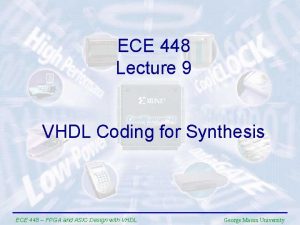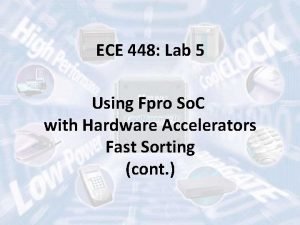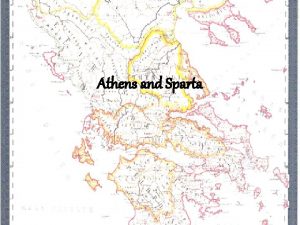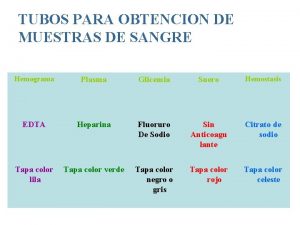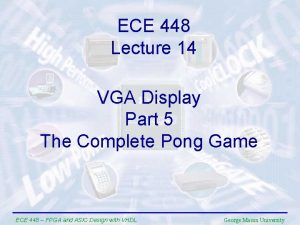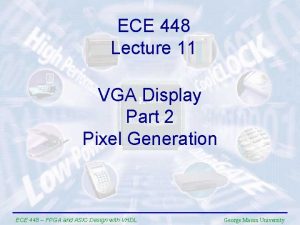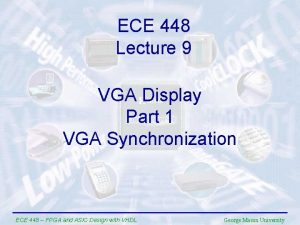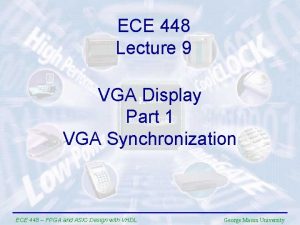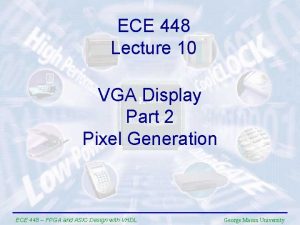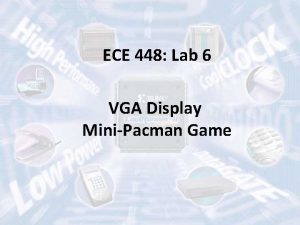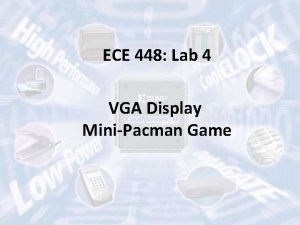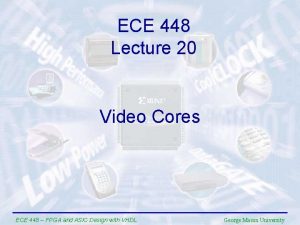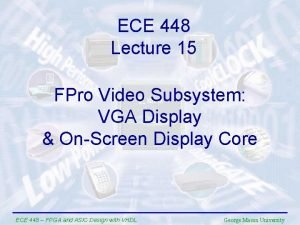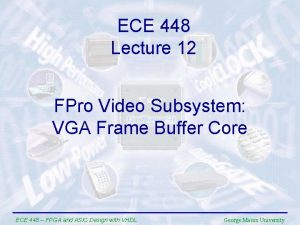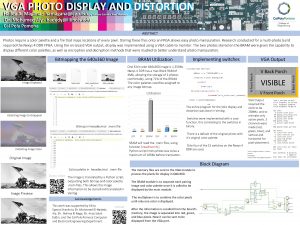ECE 448 Lecture 12 VGA Display Part 3






























- Slides: 30

ECE 448 Lecture 12 VGA Display Part 3 Animation ECE 448 – FPGA and ASIC Design with VHDL George Mason University

Required Reading • Old Edition of the Textbook 2008 (see Piazza) P. Chu, FPGA Prototyping by VHDL Examples Chapter 12, VGA Controller I: Graphic • Source Code of Examples http: //academic. csuohio. edu/chu_p/rtl/fpga_vhdl. html • Basys 3 FPGA Board Reference Manual 7. VGA Port ECE 448 – FPGA and ASIC Design with VHDL 2

PONG ECE 448 – FPGA and ASIC Design with VHDL 3

PONG • Commonly regarded as the first "commercially successful" video game • Released by Atari in 1972 • Created by Allan Alcorn as a training exercise assigned to him by Atari co-founder Nolan Bushnell • The first prototype developed completely in hardware using TTL devices • Originally used as an arcade video game • Home version released during the 1975 Christmas season ECE 448 – FPGA and ASIC Design with VHDL 4

PONG ECE 448 – FPGA and ASIC Design with VHDL 5

PONG – Interesting Videos Pong Game http: //www. ponggame. org First documented Video Ping-Pong game – 1969 https: //www. youtube. com/watch? v=XNRx 5 hc 4 g. Yc Classic Game Room HD - PONG for Nintendo DS / GBA https: //www. youtube. com/watch? v=Trez. Fj. GF-Kg ECE 448 – FPGA and ASIC Design with VHDL 6

Animation ECE 448 – FPGA and ASIC Design with VHDL 7

Animation Basics • Animation is achieved by an object changing its location gradually in each frame • We use signals, instead of constants, to determine boundaries of an object • VGA monitor is refreshed 60 times per second • The boundary signals need to be updated at this rate • We create a 60 Hz enable tick, refr_tick, which is asserted for 1 pixel period every 1/60 th of a second ECE 448 – FPGA and ASIC Design with VHDL 8

Moving the Bar (Paddle) 600 ≤ x ≤ 603 bar_y_t ≤ y ≤ bar_y_b bar_y_t = bar_y_reg bar_y_b=bar_y_t+BAR_Y _SIZE-1 BAR_V is a velocity of the bar (#pixels/frame) ECE 448 – FPGA and ASIC Design with VHDL 9

Moving the Bar in VHDL (1) -- bar left, right boundary constant BAR_X_L: integer: =600; constant BAR_X_R: integer: =603; -- bar top, bottom boundary signal bar_y_t, bar_y_b: unsigned(9 downto 0); constant BAR_Y_SIZE: integer: =72; -- reg to track top boundary (x position is fixed) signal bar_y_reg, bar_y_next: unsigned(9 downto 0); -- bar moving velocity when the button is pressed constant BAR_V: integer: =4; ECE 448 – FPGA and ASIC Design with VHDL 10

Moving the Bar in VHDL (2) -- boundary bar_y_t <= bar_y_reg; bar_y_b <= bar_y_t + BAR_Y_SIZE - 1; -- pixel within bar_on <= '1' when (BAR_X_L<=pix_x) and (pix_x<=BAR_X_R) and (bar_y_t<=pix_y) and (pix_y<=bar_y_b) else '0'; -- bar rgb output bar_rgb <= "010"; --green ECE 448 – FPGA and ASIC Design with VHDL 11

bar_y_reg, bar_y_t, and bar_y_b ECE 448 – FPGA and ASIC Design with VHDL 12

Moving the Bar in VHDL (4) process (clk, reset) begin if reset='1' then bar_y_reg <= (others=>'0'); elsif (clk'event and clk='1') then bar_y_reg <= bar_y_next; end if; end process; ECE 448 – FPGA and ASIC Design with VHDL 13

Circuit calculating bar_y_next ECE 448 – FPGA and ASIC Design with VHDL 14

Moving the Bar in VHDL (3) -- new bar y-position process(bar_y_reg, bar_y_b, bar_y_t, refr_tick, btn) begin bar_y_next <= bar_y_reg; -- no move if refr_tick='1' then if btn(1)='1' and bar_y_b <= (MAX_Y-1 -BAR_V) then bar_y_next <= bar_y_reg + BAR_V; -- move down elsif btn(0)='1' and bar_y_t >= BAR_V then bar_y_next <= bar_y_reg - BAR_V; -- move up end if; end process; ECE 448 – FPGA and ASIC Design with VHDL 15

Moving the Ball ball_x_l ≤ x ≤ ball_x_r ball_y_t ≤ y ≤ ball_y_b ball_x_l = ball_x_reg ball_x_r=ball_x_l+BALL_ SIZE-1 ball_y_t = ball_y_reg ball_y_b=ball_y_t+BALL_ SIZE-1 ECE 448 – FPGA and ASIC Design with VHDL 16

Ball Velocity • The ball may change direction by hitting the wall, the paddle, or the bottom or top of the screen • We decompose velocity into an x-component and a y-component • Each component can have either a positive value BALL_V_P or a negative value BALL_V_N • The current value of each component is kept in x_delta_reg and y_delta_reg ECE 448 – FPGA and ASIC Design with VHDL 17

Velocity Components of the Ball x x_delta_reg = BALL_V_N y_delta_reg = BALL_V_N x_delta_reg = BALL_V_P y_delta_reg = BALL_V_N x_delta_reg = BALL_V_N y_delta_reg = BALL_V_P x_delta_reg = BALL_V_P y ECE 448 – FPGA and ASIC Design with VHDL 18

Moving the Ball in VHDL (1) constant BALL_SIZE: integer: =8; -- 8 -- ball boundaries signal ball_x_l, ball_x_r: unsigned(9 downto 0); signal ball_y_t, ball_y_b: unsigned(9 downto 0); -- reg to track left, top boundary signal ball_x_reg, ball_x_next: unsigned(9 downto 0); signal ball_y_reg, ball_y_next: unsigned(9 downto 0); -- reg to track ball speed signal x_delta_reg, x_delta_next: unsigned(9 downto 0); signal y_delta_reg, y_delta_next: unsigned(9 downto 0); -- ball velocity can be pos or neg constant BALL_V_P: unsigned(9 downto 0) : = to_unsigned(2, 10); constant BALL_V_N: unsigned(9 downto 0) : = unsigned(to_signed(-2, 10)); ECE 448 – FPGA and ASIC Design with VHDL 19

Moving the Ball in VHDL (3) ball_x_l <= ball_x_reg; ball_y_t <= ball_y_reg; ball_x_r <= ball_x_l + BALL_SIZE - 1; ball_y_b <= ball_y_t + BALL_SIZE - 1; -- pixel within ball sq_ball_on <= '1' when (ball_x_l<=pix_x) and (pix_x<=ball_x_r) and (ball_y_t<=pix_y) and (pix_y<=ball_y_b) else '0'; ECE 448 – FPGA and ASIC Design with VHDL 20

Moving the Ball in VHDL (2) type rom_type is array (0 to 7) of std_logic_vector(0 to 7); constant BALL_ROM: rom_type : = ( "00111100", -- **** "01111110", -- ****** "11111111", -- ******** "01111110", -- ****** "00111100" -- **** ); signal rom_addr, rom_col: unsigned(2 downto 0); signal rom_data: std_logic_vector(0 to 7); signal rom_bit: std_logic; ECE 448 – FPGA and ASIC Design with VHDL 21

Moving the Ball in VHDL (4) -- map current pixel location to ROM addr/col rom_addr <= pix_y(2 downto 0) - ball_y_t(2 downto 0); rom_col <= pix_x(2 downto 0) - ball_x_l(2 downto 0); rom_data <= BALL_ROM(to_integer(rom_addr)); rom_bit <= rom_data(to_integer(rom_col)); -- pixel within ball rd_ball_on <= '1' when (sq_ball_on='1') and (rom_bit='1') else '0'; -- ball rgb output ball_rgb <= "100"; -- red ECE 448 – FPGA and ASIC Design with VHDL 22

Moving the Ball in VHDL (5) -- new ball position ball_x_next <= ball_x_reg + x_delta_reg when refr_tick='1' else ball_x_reg ; ball_y_next <= ball_y_reg + y_delta_reg when refr_tick='1' else ball_y_reg ; ECE 448 – FPGA and ASIC Design with VHDL 23

Bouncing y_delta_next <= BALL_V_P x_delta_next <= BALL_V_N y_delta_next <= BALL_V_N ECE 448 – FPGA and ASIC Design with VHDL 24

Circuit calculating y_delta_next ECE 448 – FPGA and ASIC Design with VHDL 25

Circuit calculating x_delta_next ECE 448 – FPGA and ASIC Design with VHDL 26

Moving the Ball in VHDL (6) process(x_delta_reg, y_delta_reg, ball_x_l, ball_x_r, ball_y_t, ball_y_b, bar_y_t, bar_y_b) begin x_delta_next <= x_delta_reg; y_delta_next <= y_delta_reg; if ball_y_t < 1 then -- reach top y_delta_next <= BALL_V_P; elsif ball_y_b >= (MAX_Y-1) then -- reach bottom y_delta_next <= BALL_V_N; elsif ball_x_l <= WALL_X_R then -- reach wall x_delta_next <= BALL_V_P; -- bounce back elsif (BAR_X_L<=ball_x_r) and (ball_x_r<=BAR_X_R) then -- reach x of right bar if (bar_y_t<=ball_y_b) and (ball_y_t<=bar_y_b) then x_delta_next <= BALL_V_N; --hit, bounce back end if; end process; ECE 448 – FPGA and ASIC Design with VHDL 27

Moving the Ball in VHDL (7) process (clk, reset) begin if reset='1' then ball_x_reg <= (others=>'0'); ball_y_reg <= (others=>'0'); x_delta_reg <= BALL_V_P; y_delta_reg <= BALL_V_P; elsif (clk'event and clk='1') then ball_x_reg <= ball_x_next; ball_y_reg <= ball_y_next; x_delta_reg <= x_delta_next; y_delta_reg <= y_delta_next; end if; end process; ECE 448 – FPGA and ASIC Design with VHDL 28

Generating ref_tick in VHDL pix_x <= unsigned(pixel_x); pix_y <= unsigned(pixel_y); -- refr_tick: 1 -clock tick asserted at start of v-sync -i. e. , when the screen is refreshed (60 Hz) refr_tick <= '1' when (pix_y=481) and (pix_x=0) else '0'; ECE 448 – FPGA and ASIC Design with VHDL 29

Vertical Synchronization ECE 448 – FPGA and ASIC Design with VHDL 30
 Fpga software
Fpga software Ece 448
Ece 448 Ece448
Ece448 Ece 448
Ece 448 Ece 448
Ece 448 Ece448
Ece448 Dvst stands for
Dvst stands for What is raster scan display
What is raster scan display Raster scan display and vector scan display
Raster scan display and vector scan display 01:640:244 lecture notes - lecture 15: plat, idah, farad
01:640:244 lecture notes - lecture 15: plat, idah, farad Cs 448
Cs 448 Joel ross uw
Joel ross uw Afsc 448 scmw saspo
Afsc 448 scmw saspo Cs 448
Cs 448 500-448
500-448 Jest głównym dopływem wisły ma 448 km długości
Jest głównym dopływem wisły ma 448 km długości Factors of 448
Factors of 448 Grafick
Grafick Vga text mode font
Vga text mode font Lfd
Lfd Komponen utama teknologi informasi terdiri atas
Komponen utama teknologi informasi terdiri atas Blitzschutz dehn pdf
Blitzschutz dehn pdf Vga
Vga Rgb vga unterschied
Rgb vga unterschied Tubos de hemograma
Tubos de hemograma Vga registers
Vga registers Vgastands for
Vgastands for Unit ratio definition
Unit ratio definition It is the heart of the entire beverage operation
It is the heart of the entire beverage operation Brainpop ratios
Brainpop ratios The part of a shadow surrounding the darkest part
The part of a shadow surrounding the darkest part



